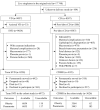Cesarean delivery on maternal request and common child health outcomes: A prospective cohort study in China
- PMID: 35265334
- PMCID: PMC8878985
- DOI: 10.7189/jogh.12.11001
Cesarean delivery on maternal request and common child health outcomes: A prospective cohort study in China
Abstract
Background: Cesarean delivery vs vaginal delivery was reported to increase the risks of childhood obesity, pneumonia, anemia, and neurobehavioral disorders, but few studies were able to deal with the confounding biases associated with medical conditions indicating cesareans. This prospective cohort study aims to investigate the associations of non-medically indicated cesarean delivery on maternal request (CDMR) with these child health outcomes.
Methods: Among 17 748 liveborn infants whose mothers (primiparas) participated in a randomized controlled trial on micronutrient supplementation and pregnancy outcomes during 2006-2009 in 5 rural counties in Hebei Province, China, 6972 singletons born by full-term spontaneous vaginal delivery (SVD) and 3626 by CDMR were extracted for the assessments of obesity (weight-for-height z-score >3) and pneumonia (self-reported) at 1.5-5 years in 2011. Some children were further randomly selected from these two groups for the assessments of anemia (hemoglobin <110 g/L, 2341 SVD and 2417 CDMR) and neurobehavioral disorders (raw score of Child Behavior Checklist larger than the 90th percentile of the normative sample, 1257 SVD and 1060 CDMR).
Results: Compared with SVD, CDMR was associated with increased risks of obesity (adjusted odds ratio (aOR) = 1.41, 95% confidence interval (CI) = 1.14-1.75, P = 0.002) and anemia (aOR = 1.65, 95% CI = 1.28-2.12, P < 0.001), but not with the risk of pneumonia (aOR = 1.16, 95% CI = 0.94-1.45, P = 0.17) or neurobehavioral disorders (aORs varied from 0.82 to 0.91, P > 0.05) in childhood.
Conclusions: Cesarean delivery, independent of cesarean indications, is likely associated with childhood obesity and anemia, indicating a need to keep pregnant women informed, especially those seeking CDMR, a need to explore possible improvement on obstetric service, and even a need for main stakeholders to reach a compromise in making a cesarean decision.
Trial registration: ClinicalTrials.gov: NCT00133744 and NCT01404416.
Copyright © 2022 by the Journal of Global Health. All rights reserved.
Conflict of interest statement
Competing interests: The authors completed the ICMJE Unified Competing Interest Form (available upon request from the corresponding author), and declare no conflicts of interest.
Figures
Similar articles
-
Cesarean delivery on maternal request and its influencing factors in Chongqing, China.BMC Pregnancy Childbirth. 2021 May 19;21(1):384. doi: 10.1186/s12884-021-03866-7. BMC Pregnancy Childbirth. 2021. PMID: 34011289 Free PMC article.
-
Caesarean delivery, caesarean delivery on maternal request and childhood overweight: a Chinese birth cohort study of 181 380 children.Pediatr Obes. 2014 Feb;9(1):10-6. doi: 10.1111/j.2047-6310.2013.00151.x. Epub 2013 Mar 19. Pediatr Obes. 2014. PMID: 23512941
-
Does vaginal delivery mitigate or strengthen the intergenerational association of overweight and obesity? Findings from the Boston Birth Cohort.Int J Obes (Lond). 2017 Apr;41(4):497-501. doi: 10.1038/ijo.2016.219. Epub 2016 Nov 30. Int J Obes (Lond). 2017. PMID: 27899809 Free PMC article.
-
Cesarean delivery on maternal request: maternal and neonatal complications.Curr Opin Obstet Gynecol. 2008 Dec;20(6):597-601. doi: 10.1097/GCO.0b013e328317a293. Curr Opin Obstet Gynecol. 2008. PMID: 18989137 Review.
-
Elective cesarean delivery on maternal request.JAMA. 2013 May 8;309(18):1930-6. doi: 10.1001/jama.2013.3982. JAMA. 2013. PMID: 23652524 Review.
Cited by
-
Prevalence and factors associated with caesarean delivery on maternal request and its effect on maternal and foetal outcomes in selected tertiary care hospital, Odisha, Southeastern India.J Glob Health. 2025 Mar 21;15:04073. doi: 10.7189/jogh.15.04073. J Glob Health. 2025. PMID: 40116852 Free PMC article.

